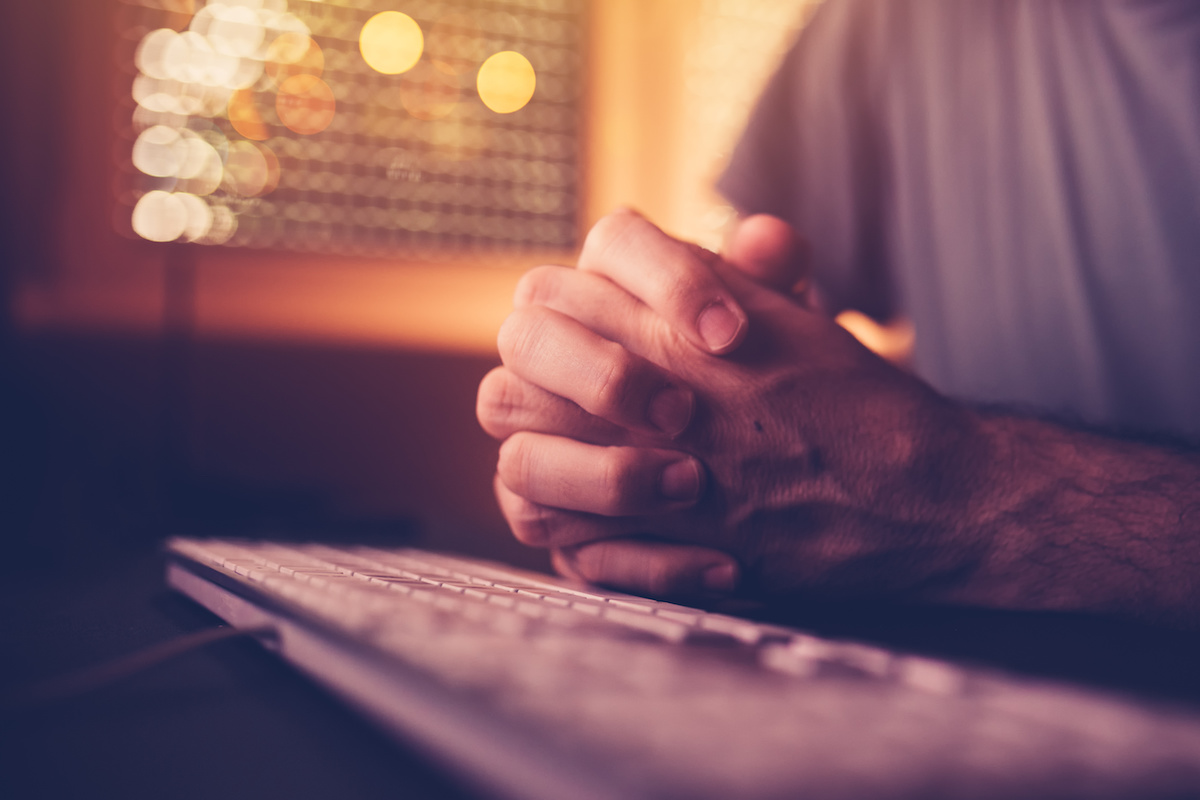COVID-19
God and the Pandemic
For many established religious institutions, the pandemic threatens to exacerbate an ongoing retreat from organized religion.

If God gives you technology, use it to reach people!
~Rabbi David Eliezrie The Secret of Chabad
During this most miserable of years, religion, like virtually every major social institution, has been profoundly disrupted. There have been church closures and the ranks of outdoor—or socially distanced—worshipers represent a mere fraction of those who engaged before. Yet the pandemic may also mark a critical breaking point, leading to profound changes in how spirituality is experienced and sustained. In some senses, we are witnessing a shift as important as that brought about by Guttenberg’s press and Luther’s vernacular Bible during the Reformation. As sociologist and historian Max Weber suggested, these developments overturned the notion that “magic and the supernatural quest for salvation” belonged to the Latin-speaking priesthood.1 The pandemic and the flood of new online spiritual offerings have combined to transform religious life in much the same way.
This will be a disruptive and painful transition for many established religious institutions; empty pews and church closures augur what Fordham’s David Gibson has called a “religious recession.” COVID-19 restrictions, some research suggests, could end up eliminating five percent of America’s churches this year, particularly smaller congregations, particularly in poor, rural, or remote areas. But Gibson points out that other commentators believe that the current disruption is more likely to usher in an era of religious reawakening and revival in which people reject organized faiths but maintain some spiritual values. Today, fewer people than ever attend church, but two-thirds of unaffiliated Americans polled by Pew still believe in God or some kind of “universal spirit.” Increasingly, these searchers address their spiritual needs online, at home, and through specific programs.
Religion and periods of social stress
Although hardly as lethal as the ancient plagues, the current pandemic has taken an enormous toll on our sense of wellbeing. Gallup reports the highest levels of mental anguish for 20 years in the United States, a phenomenon also evident in the United Kingdom and Europe. Yet, historically, religions have expanded during periods of extreme stress, a trend that provides grounds for a spiritual rebirth. As church attendance has plummeted—two-thirds of US Protestant churches have suffered a decline this year of 50 percent or more—virtual church attendance is booming. According to Pew, a quarter of Americans say the pandemic has bolstered their faith, a finding confirmed by Gallup. Today, many online churches are flourishing, some with as many as 70,000 virtual attendees. Google searches for “prayer” and “Christianity” have “skyrocketed,” not only in the US but around the world. Danish researcher Jeanet Sinding Bentzen found requests for religious sources and prayers has grown dramatically, even in heavily secularized Europe. Similarly, one of the UK’s largest online Christian bookstores, Eden, saw physical Bible sales rise by 55 percent in April.
This reprises past experience. During the plague-ridden days of the late Roman Empire, Christianity gained over pagan cultures by offering counsel, comfort, and philosophical explanations.2 Historian William McNeill speaks of the “sublime capacity” of the early Christian to cope with plagues and offer hope that was critical to the Church’s rise.3 Those making the transition tend to be focused on addressing the pandemic-caused dilemmas faced by the vast majority of people. The evangelical group Global Media Outreach has gone from reaching 350,000 people per day to upwards of 500,000 globally. A GMO leader told the Christian Post, “People are coming to us saying, ‘I need hope. Where can I find hope in the face of tragedy, anxiety, bankruptcy?’” He added, “When people are in pain, we offer encouragement and hope. They’re coming to us looking for answers.”

The de-establishment
For many established religious institutions, the pandemic threatens to exacerbate an ongoing retreat from organized religion. This applies not only to Europe, where well over 50 percent of those under the age of 40 do not identify with any religion, but also in the United States, considered the most religious of high-income countries, where almost 40 percent of people aged 18–29 now claim no religious affiliation. This erosion among the faithful has weakened the financial strength of religious institutions of all kinds, including even the mighty Vatican. One-in-three US congregations has no savings, according to the 2018–2019 National Congregations Study, an ongoing survey conducted at Duke University Divinity School. Just 18 percent have a year’s cushion. In Minneapolis, local churches have taken the hit, and poorer ones have shown a 70 percent decline in donations. Many of these, notes Florida-based religious consultant Brock Gant, “are not prepared with technology. Some are simply giving up and many will be gone.”
A survey by the Public Religion Research Institute found that one-third or more of those who had previously attended church regularly were not bothering to watch online services. For those whose church affiliation was already tenuous, the disconnect may be permanent. Recent data suggests that as many as one-in-three practicing US Christians are “church hopping” digitally while another third appear to have “dropped out altogether.” Ultimately, the Churches that survive will be those that can adjust their models. “Jesus’s followers believe that his Church is here to stay. Models of Church, and even great church institutions, will come and go,” observes Chris Morton, director for strategic initiatives for Fresh Expressions, a British-based international movement of missionary disciples. “Those who don’t survive the pandemic were likely on their way out already.”
Even growing religions, such as Islam, have suffered reductions of 25–50 percent in contributions, despite demand for such things as food pantries soaring five-fold. Islam, notes Furhan Zubairi, dean of a Southern California Islamic academy called the IOK Seminary, revolves around shared worship, culminating in the annual haj. The impossibility of gathering en masse undermines the appeal of a faith community deeply tied to social interaction. “Rituals are about repetition,” notes Muslim author Mucahit Bilici. “Interrupting them harms their spontaneity and saps their strength.”
Ritual is particularly critical for the Catholic Church, the Western world’s largest religious grouping. Josephine Everly, chief development officer of the Leadership Roundtable, a Catholic organization promoting best practices for the Church, has said that “giving remotely is a tough sell for Catholics, because the seven sacraments of the Roman Catholic Church, including Holy Communion, are shared within the four walls of the church.” Tony Lemus is an astrophysicist and prominent member of the Magis Institute, which was founded by the renowned Jesuit priest and philosophical expert Father Robert Spitzer to help innovate new ways to spread the faith. Lemus has been highly critical of the Church’s performance during the pandemic. Much of the problem, he argues, lies in its bureaucratic structure, which is dominated by a generally older, not-tech-savvy priesthood. “You can’t get through to them,” he laments. “It’s a bureaucracy that’s out of touch. This could put the church out of business in the long term.”
Who has done best with the pandemic?
While many of the oldest and most well-established religious institutions struggle, others have found opportunity during the pandemic. Dynamic preachers like the Southern California-based Rick Warren have used their established media presence to great effect. After COVID-19, the pastor of Saddleback Church reports, his online church attendance more than doubled to 100,000 while charitable efforts have increased. “Our buildings have been closed, but the Church is not a building!” he says. “We are a living, breathing body. The church is a family, not a fortress! We are a people, not a place! We’re an army of servants, not an event of attenders.”
Similarly, while mosques are suffering from declining revenues and lost connections with their adherents, the elite of charismatic Muslim preachers is thriving. Furhan Zubairi sees growing appeal for charismatic preachers like Africa-based Mufti Dr Ismail Menk, Swiss-based Imam Suhaib Webb (known as the “snapchat Imam”), or Dallas-based Imam Omar Suleiman. With the suspension of local, physical, religious experience (outside of one’s own house),” notes author Mucahit Bilici, “self-styled authority figures in the digital Muslim public sphere gain an unprecedented equivalence with local imams and community leaders.”
Perhaps the most successful adjustments among the established religions has occurred in the Church of Jesus Christ of Latter-Day Saints (LDS), more widely known as Mormons. Although the Utah church of 16 million adherents has continued to expand, particularly overseas, it has had a difficult time keeping the new generation active; Jana Riess, a Mormon author, suggests the Church’s own data suggests that barely one-in-four young LDS members are active. Yet, unlike the Catholic Church, with its huge bureaucracy, the LDS is run largely by laypeople, and many of them, notably in the base in Salt Lake, possess strong technical skills.
In 2018, the Church under its president, the eminent physician Russell Nelson, was already dealing with the challenge of the digital age by driving more religious worship and study to digital platforms at home. The program, dubbed “Come Follow Me,” puts an entire library of resources online that can be found on the Gospel Library page of its website. “The church is full of technology people, who want to find a way to market the faith,” notes Robert Grow, a prominent Salt Lake LDS leader. “We are making the transition because so many of our lay leadership have the skills. Our community is getting stronger in this situation.”
Chabad and the evolution of Judaism
Like many other religious establishments, mainstream synagogue Judaism has been in decline for decades. Between 2001 and 2020, the overall number of traditional synagogues declined by a third across the country, with closures of 20 percent or more in 34 states. Most observers believe that the pandemic will worsen this situation. “The many Jewish institutions that rely on attendance, membership dues, and other sources of revenue may not be able to hold on until the crisis is over,” wrote David Suissa, publisher of the LA Jewish Journal recently.
Chabad, a grassroots Jewish evangelical group, has pivoted far more successfully—its number of synagogues has tripled since 2001 from 346 to approximately 1,036. A dispersed organization without membership structures, Chabad offers an alternative to institutional Judaism’s traditional system of membership fees, camp costs, and school tuitions. Rabbi Sid Schwarz, author of Jewish Megatrends, says that these costs fail as a “value proposition” because they are too expensive, particularly for young families. Chabad, on the other hand, often operates with limited bureaucracy in places like strip malls and can therefore offer a more accessible alternative.
During the pandemic, Chabad has shown both foresight and flexibility. Like the LDS, Chabad was an early tech adopter. Rabbi Menachem Posner, staff editor at Chabad.org, says that it has been innovating with technology since before the Internet. Early adopters of vinyl records, radio, and television, the organization was an early adopter of the Internet as well. In the 1980s, the Lubavitcher Hasidic organization began experimenting with computer bulletin boards and listservs. They registered the Chabad.org domain on the brand-new worldwide web in 1994, the same year as Yahoo! Chabad.org was formed ahead of Google, Facebook, Twitter, Instagram, or WhatsApp.
This approach has paid off. According to Rabbi Posner, Chabad.org logged 54 million unique visitors last year. Chabad has another domain, Rohr Jewish Learning Institute (JLI), which provides structured educational content, curricula, lessons, and lesson plans for day schools, lectures, seminars, and home study. There are over 15,000 classes online, accessible through every Chabad Center website. The JLI website logged an average 50,000 participants a week before COVID, and these have increased by 25–30 percent since March.

The future of religious journey: more fluid, diverse, and de-established
“Religion is a central defining characteristic of civilizations,” observed Samuel Huntington in The Clash of Civilizations.4 As we finally emerge from the pandemic, we will find that religion has been transformed in ways that will shape our beliefs and how we express them. Just as the translations of Luther into German and John Wycliffe’s earlier into English changed the nature of people’s relationship to God, the movement onto digital platforms will make spirituality more immediate and variable.
By breaking up the old patterns of worship, the pandemic has disrupted religious order around the world and changed religious life in ways that may remain for decades ahead. In the future, even the sharp distinctions between religions may erode as individuals surf between options. We need to find good venues for them to shop, in what the late Christian theologian Wade Clark Roof called the “spiritual marketplace.” This dynamic may be particularly critical for younger people, who may be less attached to institutions but are nevertheless seeking the kind of self-transformation that Roof calls “genuine and personally satisfying.”5
Even though most congregants expect to return to church after the pandemic, the de-establishment and dispersion of faith is likely to continue. Shawn Landres, a prominent Jewish social entrepreneur speaks of the “unbundling” of religious functions into its component parts, many of which can now be accessed independently, without institutional commitment or expense. This new “modular” worship may be replacing old institutional frameworks, creating new institutions that “reflect contemporary realities and meet the needs of the individuals they engage and serve” rather than those of their founders. More importantly, these new institutions eschew “membership” in favor of “participation” in which “the guarantor of an organization’s long-term impact is neither real estate nor an endowment, but rather network resilience”
In a sense, this new religiosity may follow the notion, first suggested by the late Alvin Toffler, of the “prosumer,” in which individuals drive the marketplace, including in faith. We will likely see more specificity in affiliation, for example, gatherings of people who might be gay, or who see religion through the prism of an ideology, like environmentalism, social justice, or traditionalism. This new order will become more evident as millennial and Gen Z “digital natives” enter their 30s, start families, and seek permanent meaning in their lives. Like earlier generations, they may seek moral education and community involvement, but in more digitally driven forms than those before them. In short, we may not be witnessing the eclipse of religious life, but rather its reinvention. God may not be dead after all. Instead, He will exist not in great cathedrals, mosques, or synagogues, but on the screens that increasingly shape our lives.
References:
1 Max Weber, Economy and Society, Volume 1, edited by Guenther Roth and Claus Wittich, Berkeley, CA: University of California Press, 1979, p. 630
2 Kyle Harper, The Fate of Rome, (Princeton, NJ: Princeton University Press, 2017), p.156
3 William McNeill, Plagues and Peoples, (Garden City, New York: Doubleday, 1976), pp.122-123, p.182
4 Samuel P. Huntington, The Clash of Civilizations, and the Remaking of World Order (New York: Simon & Schuster, 1996), 47.
5 Wade Clark Roof, Spiritual Marketplace: Baby Boomers and the Remaking of American Religion, (Princeton, NJ: Princeton University Press,1999), p.9
CORRECTION: An earlier version of this article misidentified Wade Clark as Wayne. Quillette regrets the error.






